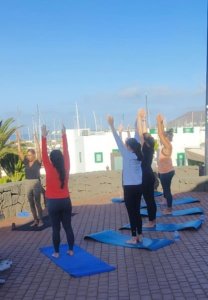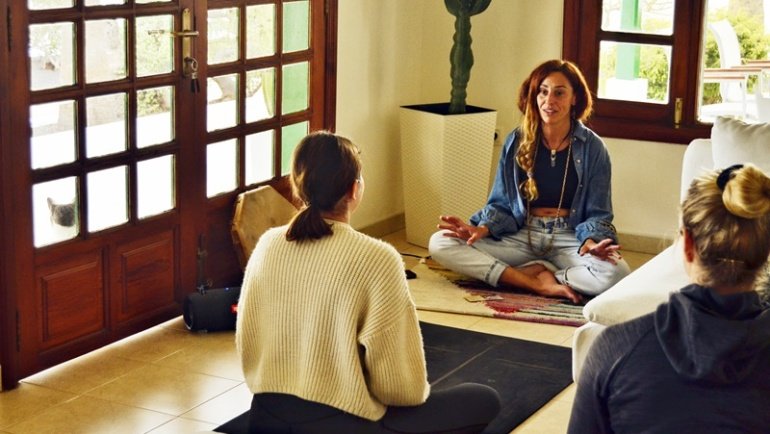Hatha Yoga in Playa Blanca, Lanzarote, is an invitation to discover the harmony between body and mind. We offer individual and group classes where you can experience postures, breathing techniques, and meditation, promoting a healthy and conscious lifestyle in this beautiful setting.

If this vibe resonates with you, let me guide you. Contact me via WhatsApp to reserve a date and time.
What is Hatha Yoga? The foundation of all practices
Hatha Yoga is a yoga practice that focuses on the integration of body and mind through various techniques. This modality is considered the cornerstone of many other yoga practices in the modern world.
Philosophy of Hatha Yoga
The philosophy behind Hatha Yoga is rich and complex. One of the overriding concepts is the idea of ”yoga” as union, which seeks a connection between the individual being and the universe. In this context, the body is seen as a sacred vehicle, and the practice aims to purify it to allow an unhindered flow of energy.
Another fundamental principle is ahimsa, which translates as “nonviolence.” This concept extends beyond relationships with others and encompasses self-care and self-respect. Hatha Yoga fosters compassion and understanding, both toward oneself and others.
The Deep Meaning of Hatha: Union between Sun and Moon
The term Hatha, which translates as “act of effort,” encapsulates the essence of a practice that seeks to integrate and harmonize diverse energies within our being. The union between “ha” (sun) and “tha” (moon) is fundamental to understanding how these energies manifest in practice.
Symbolic interpretation of ‘ha’ and ‘tha’
- ‘Ha’ (sun): Symbolizes masculine energy, creativity, and activity. It represents light, action, and warmth. In the body, it is associated with vitality and drive.
- ‘Tha’ (moon): Represents feminine energy, receptivity, and introspection. It is a symbol of calm, coolness, and passivity, related to intuition and inner connectivity.
The union of these energies creates a balance that allows practitioners to experience a state of holistic well-being. Understanding this symbolism provides a solid foundation for deepening the practice.
Balance of energies in the body
The practice of Hatha Yoga seeks harmony between the masculine and feminine energies within each individual. This balance is manifested through various techniques, such as:
- Asanas: Physical postures help align and balance the body’s energies, facilitating a more harmonious flow of energy.
- Pranayama: These breath control techniques help regulate and balance prana, or life energy, restoring inner harmony.
- Meditation: Meditation acts as a bridge between body and mind, allowing a deeper connection with oneself and promoting inner peace.
The balance of these forces is reflected in overall health, positively influencing the physical, emotional, and spiritual aspects of the individual.
Impact on daily practice
Recognizing the duality represented by ‘ha’ and ‘tha’ transforms daily practice. Incorporating this perspective brings a new dimension to the yoga experience. Some key aspects include:
- Mindfulness: Integrating mindfulness into daily activities fosters a greater connection with oneself and one’s surroundings. This mindful approach supports peace of mind.
- Self-awareness: The practice of Hatha Yoga facilitates self-awareness, allowing practitioners to recognize their own energies and how they manifest in their daily lives.
- Adaptability: Understanding the balance between the sun and the moon encourages practitioners to be flexible in their lives, adapting their approach according to the situations and emotions they face.
Understanding the union of these energies becomes a guide for facing life’s challenges, offering a balanced and serene perspective on the world.
Hatha Yoga as the foundation of all yoga styles
The practice of Hatha Yoga has served as the foundation upon which numerous contemporary yoga styles have developed. Its teachings have profoundly influenced the evolution of these modalities, ensuring that its essence endures in diverse practices and approaches.
Influence on modern styles
The influence of Hatha Yoga on modern styles is undeniable. Many contemporary styles, such as Vinyasa, Ashtanga, and Iyengar, have borrowed postures, breathing techniques, and meditation principles from Hatha Yoga. Below are some styles that owe their development to Hatha Yoga:
- Vinyasa: This fluid style combines postures in dynamic sequences while synchronizing breath with movement, a principle originating in Hatha Yoga.
- Ashtanga: It is based on specific series of postures that promote strength and flexibility, following fundamental structures of Hatha Yoga.
- Iyengar: Focusing on body alignment and the use of supports, this style uses Hatha fundamentals to benefit practitioners of all levels.
- Yin Yoga: Focused on relaxation and deep stretching, it is complemented by the attention to breath fostered in Hatha Yoga.
Benefits of Hatha Yoga for the body, mind and spirit
Hatha Yoga offers a wide range of benefits that transcend the physical realm, directly impacting the emotional and spiritual well-being of those who practice it.
Physical benefits of Hatha Yoga
Improved flexibility and strength
Regular Hatha Yoga practice allows for a noticeable improvement in flexibility and muscle strength. Performing asanas stretches and strengthens muscles, contributing to a broader and healthier range of motion. This can be especially helpful in preventing injuries and relieving accumulated tension in the body.
Cardiovascular and postural benefits
Hatha Yoga not only focuses on improving flexibility but also promotes cardiovascular health. The various postures stimulate blood circulation and help normalize blood pressure. Furthermore, a committed practice contributes to better postural alignment, which relieves common ailments such as back pain and neck discomfort.
Mental benefits of Hatha Yoga
Stress reduction and improved concentration
Hatha Yoga’s breathing and meditation techniques help reduce stress levels. The practice helps release accumulated tension, allowing the mind to calm and focus. This translates into greater mental clarity and an improved ability to concentrate on various daily tasks.
Emotional balance and self-awareness
Through the connection between body and mind, Hatha Yoga fosters greater self-awareness. This mindful process helps manage and understand difficult emotions, offering tools to cultivate lasting emotional balance. Regular practice can be especially effective for those seeking to develop a healthier relationship with themselves and others.
Spiritual benefits
- Strengthening Inner Connection
- Cultivating Inner Peace
How to Get Started with Hatha Yoga: Essential Principles and Key Postures
Getting started in Hatha Yoga requires certain foundations and a basic understanding that will help establish a safe and enriching practice. The goal is to create an environment conducive to connection and introspection.
Key postures of Hatha Yoga
Tadasana (Mountain Pose)
Considered one of the most basic yet powerful postures, Tadasana helps establish a solid foundation. It contributes to postural alignment and connection with the breath.
Adho Mukha Svanasana (Downward-Facing Dog Pose)
This asana is excellent for stretching the spine and strengthening the arms and legs. It helps activate the flow of energy and calm the mind, providing a revitalizing effect.
Bhujangasana (Cobra Pose)
Cobra pose strengthens the lower back and opens the chest. It focuses on opening the hips and improving flexibility, making it ideal for relieving accumulated tension.
Padmasana (Lotus Pose)
This position is commonly used in meditation, promoting mental calm and concentration. Practicing it promotes stability and facilitates connection with internal energy.
Finally… Preparation for practice
Creating a suitable space
It’s essential to have a space that encourages tranquility and concentration. A well-ventilated space with a serene atmosphere is ideal. Some aspects to consider are:
- Lighting: Choose soft or natural light.
- Surface: A flat, comfortable floor or a specialized yoga mat.
- Decorative elements: Use plants or images that inspire peace and harmony.
- Eliminate distractions: Keep the area free of objects that could interrupt your practice.
Recommended clothing and accessories
Clothing plays an essential role in comfort during practice. It is recommended to wear clothing that allows freedom of movement and fluidity. The following items are suggested:
- Breathable clothing: fabrics that absorb sweat and allow ventilation.
- Footwear: It is preferable to practice barefoot to maintain a better connection with the floor.
- Accessories: A non-slip mat and blocks can help facilitate some postures.
A gentle, relaxing massage would be most appropriate after a Hatha Yoga class. The goal is to complement the sense of calm and openness sought in this practice, rather than to stimulate or deeply work the muscles. Some good options include:
TRADITIONAL THAI MASSAGE
AYURVEDA MASSAGE
LAVANDA ZEN
| Tipo | Nombre del masaje |
|---|---|
| Masaje Relajante | ZEN DREAM |
| Masaje Relajante | TOK SEN |
| Masaje Relajante | MASAJE OCEÁNICO |
| Masaje Especial | MASAJE DEEP DEPORTIVO |
| Masaje Especial | MASAJE TRADICIONAL THAI |
| Masaje Especial | REFLEXOLOGÍA PODAL |
| Nuestra Esencia | LAVANDA ZEN |
| Nuestra Esencia | MASAJE AYURVEDA |

PRIVATE AND GROUP YOGA CLASSES OUTDOORS
Follow me on my Channel






